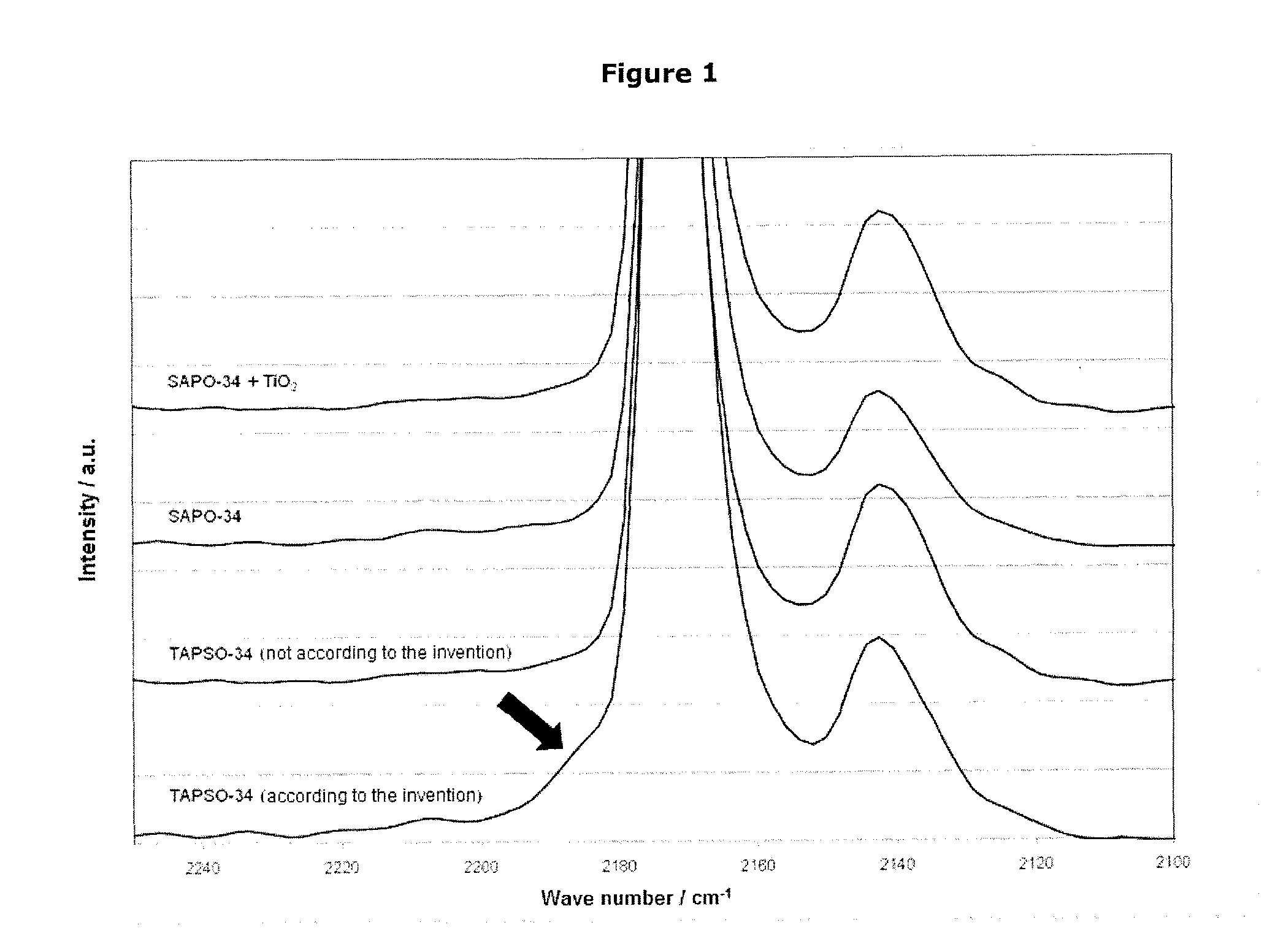Titano-silico-alumino-phosphate
a technology of silicon-silico-alumino-phosphate and titano-silico-alumino-phosphate, which is applied in the direction of silicon compounds, physical/chemical process catalysts, other chemical processes, etc., can solve the problems of inability to use sapo-34, inability to modify, and inability to exchange metals, etc., to achieve good catalytic properties, high adsorption capacity and hydrothermal stability
- Summary
- Abstract
- Description
- Claims
- Application Information
AI Technical Summary
Benefits of technology
Problems solved by technology
Method used
Image
Examples
example 1
Production of TAPSO-34 According to the Invention
[0092]100.15 parts by weight deionized water and 88.6 parts by weight hydrargillite (aluminium hydroxide SH10) were mixed. 132.03 parts by weight phosphoric acid (85%) and 240.9 parts by weight TEAOH (tetraethylammonium hydroxide) (35% in water), and then 33.5 parts by weight silica sol and 4.87 parts by weight silicon-doped titanium dioxide were added to the obtained mixture, with the result that a synthesis mixture with the following composition was obtained:[0093]Al2O3: P2O5:0.3 SiO2: 0.1 TiO2:1 TEAOH:35 H2O
[0094]The synthetic gel mixture with the above composition was transferred into a stainless-steel autoclave. The autoclave was stirred and heated to 180° C., wherein this temperature was maintained for 68 hours. After cooling the obtained product was filtered off, washed with deionized water and dried in the oven at 100° C. An X-ray diffractogram of the obtained product showed that the product was pure TAPSO-34 according to the ...
example 2
Hydrothermal Long-Term Stress Test
[0096]A titano-silico-aluminophosphate according to the invention (TAPSO-34) with 3.4 wt.-% Ti (obtained as in Example 1 with correspondingly matched composition of the synthetic gel), a titano-silico-aluminophosphate not according to the invention (TAPSO-34) with 0.5 wt.-% Ti and a silico-aluminophosphate not containing titanium (SAPO-34) were treated with water to determine the hydrothermal long-term stability over a longer period of time at different temperatures.
[0097]Small-pored molecular sieves with CHA structure have high adsorption capacities but, depending on the titanium proportion in the structure, have different hydrothermal stability. Therefore, in addition to the titano-silico-aluminophosphate (TAPSO-34) according to the invention also a titano-silico-aluminophosphate not according to the invention (TAPSO-34), with low titanium proportion and a silico-aluminophosphate not containing titanium (SAPO-34) were selected and examined in the ...
example 3
IR Spectroscopy
[0102]To determine the titanium position in the lattice the titano-silico-aluminophosphate according to the invention was examined with IR spectroscopy. Because the hydrothermal stability is increased or defined by inserting the titanium atoms into the framework of the titano-silico-aluminophosphate, the increased hydrothermal stability of the titano-silico-aluminophosphate can be determined by determining the inserted titanium in the framework structure.
[0103]The titanium atoms are determined by means of indirect determination by adsorption of CO at the free binding site of the tetrahedrally coordinated titanium, accompanied by the formation of a pentahedrally coordinated titanium. After a CO adsorption of the titano-silico-aluminophosphate according to the invention (TAPSO-34) a characteristic CO—Ti vibration band can be detected at 2192±5 cm−1 in the IR spectrum.
[0104]To determine the increase in stability of comparable substances, SAPO-34 not containing titanium a...
PUM
| Property | Measurement | Unit |
|---|---|---|
| Temperature | aaaaa | aaaaa |
| Temperature | aaaaa | aaaaa |
| Temperature | aaaaa | aaaaa |
Abstract
Description
Claims
Application Information
 Login to View More
Login to View More - R&D
- Intellectual Property
- Life Sciences
- Materials
- Tech Scout
- Unparalleled Data Quality
- Higher Quality Content
- 60% Fewer Hallucinations
Browse by: Latest US Patents, China's latest patents, Technical Efficacy Thesaurus, Application Domain, Technology Topic, Popular Technical Reports.
© 2025 PatSnap. All rights reserved.Legal|Privacy policy|Modern Slavery Act Transparency Statement|Sitemap|About US| Contact US: help@patsnap.com

